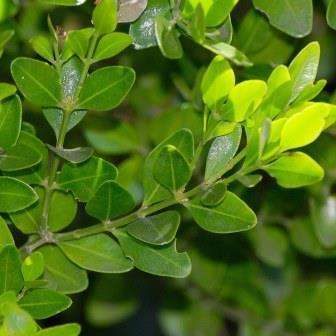
5 Buxus macowanii Seeds - Cape Box - Indigenous South African Endemic Tree Seeds + GET FREE SEEDS
Check my rate
| Main centres: | 1-3 business days |
| Regional areas: | 3-4 business days |
| Remote areas: | 3-5 business days |

| Main centres: | 1-3 business days |
| Regional areas: | 3-4 business days |
| Remote areas: | 3-5 business days |

Buxus macowanii Seeds
Cape Box; Buig-my-nie, Afrikanse Buksboom

This attractive plant belongs to a family of over thirty species of trees, shrubs and herbs belonging to seven genera. The members are widely distributed throughout the temperate counties of the globe, excluding America and Australia. Members are characterized by simple, evergreen leaves, opposite or alternating, no stipule and male and female flowers are separate (either on the same or separate plants). B. macowanii mainly originates from the Eastern Cape forests, occurring in the coastal belt extending to southern Natal (up to Oribi Gorge). It was previously thought to occur only from Alexandria to Lusikisiki, seldom more than 32 km and often within 9 km from the sea. However it is now known to extend to the eastern Northern Province where it has been collected in a wooded kloof in the Waterberg district. The Cape box is a small, very slow-growing tree up to about 9m tall. It has a clean slender, greeny-brown stem of up to 30 cm in diameter. Shiny green leaves create the crown. The twigs are angled, slightly hairy when young and smooth when old. The leaves are opposite and entire. They are arranged at right angles to each other and are up to 2.5 cm long. They are oval to widely lance-shaped, with a bluntly pointed or round apex and are narrow at the base. They are deeply green, leathery; smooth both sides, with the lateral veins scarcely visible. The flowers bloom from late winter to spring (July to October), and male and female flowers are borne separately on the same tree. This is called a "monoecious" situation. The male flowers are held in short heads in the axils of the leaves and the female are usually single or occasionally grouped. The fruit is a small brown capsule, about 7mm in diameter and holds shiny black seeds. Fruit ripens from late summer to early winter (February to June). Once ripe, the fruit splits to release the seeds. The wood of B. macowanii is very beautiful. It is yellow, hard, fine-grained and has a smooth texture. It is used for clay-modelling tools, musical instruments, model-making and was once in great demand for engraving; especially for printing. It is also used for firewood. Although much of South Africa's best timber was exploited in the early days of settlement, the Cape Box was strangely enough neglected until 1883 when it was only used for firewood. Then from 1886 onwards export trade of this species with Europe began and thus its exploitation. The wood of the Cape box resembles that of Buxus sempervirens, which is the European Box.
